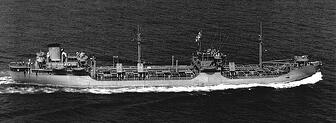Let’s get in a DeLorean and travel back in time. We’ll go back 57 years.
You’re standing on a dock at the busy Port of Newark as large numbers of union dockworkers load a ship.Ocean freight cargo in bags, barrels, crates, and even loose items are being loaded onto a ship. A large sack next to you is open. Looks like a few items have been taken as it waits to be loaded with all the other loose items going on the ship.
This is the way ocean freight shipping is done in 1956 and has been done for as long as any of the longshoremen can remember. It’s called break bulk shipping. Loading and unloading a ship takes as long as it does for a ship to sail across the sea to its destination. The costs of labor, time, and stolen items like whatever was in the sack next to you make doing international business fiscally impossible for most companies.
 Suddenly, the dockworkers stop. You follow their curious gazes down the port to what looks like a WWII oil tanker. Painted on it are the words SS Ideal X.
Suddenly, the dockworkers stop. You follow their curious gazes down the port to what looks like a WWII oil tanker. Painted on it are the words SS Ideal X.
Dockworkers can’t believe their eyes as you witness large, metal boxes craned directly off truck chasses and onto the ship.
“That’s that ship owned by Malcom McLean. He don’t know nothin’ about ocean shipping,” shouts a dock manager. “Get back to work!”
Nervous grumblings are heard from the longshoremen. “There’s more people watching that thing than loading it.” “Are they going to start loading all the ships ’round here like that?” “We goin’ ta lose our jobs?”
Freddie Fields, a top official of the International Longshoremen’s Association watches the ex-tanker get loaded in disgust. “I’d like to sink that son of a bitch,” he says.
A gust of wind blows today’s paper in your face that was discarded by one of the dockworkers as they get back to loading all the various items on the ship in front of them. Remember the date printed at the top:
Thursday, April 26 1956.
This is a date that quietly marked history and began a process of change that made the world what it is now.
It’s true that Malcom McLean was not very experienced in ocean shipping. Saving up money from his job pumping gas, McLean bought a truck and founded the McClean Trucking Co. with his siblings.
He built the company up into the second largest trucking company in the United States. As he looked into moving cargo from his trucks onto ships, McLean saw the inefficiencies of break bulk loading and the wasted cargo space that would be created by putting whole trucks on ships. So he innovated.
His concept was shipping containers that could be removed from the chasses of trucks, loaded onto ships, and then put back onto the chasses of trucks or on trains and continue to be transported.
Similar ideas had been tried in different parts of the world through history, but never as successfully as Malcolm McLean’s design.
Because law prevented a trucking company from also owning a ship line, McClean sold his trucking company in 1955 and bought the Pan-Atlantic Steamship Company and the Gulf Florida Terminal Company.
He bought a couple WWII tankers and converted them to carry his new shipping containers and on April 26, 1956, intermodal cargo transportation was being pioneered as the SS Ideal X shipped 58 35-foot shipping containers from Port Newark, New Jersey to the Port of Houston, Texas, where the shipping containers were loaded onto trucks.
Back then, longshoremen hand-loading a ship cost $5.86 a ton. Shipping containers brought the cost down all the way to 16 cents a ton.
Containerized shipping has completely transformed cargo transportation, opening up international trade and a world economy the likes of which was previously unheard of.
At the same time as container shipping created jobs by growing ship lines, ports, and businesses by dramatically increasing shipping profits and making it possible for products of all kinds to be imported and exported easily, there were many jobs on the docks were lost due to containerized shipping.
Using container shipping instead of break bulk shipping made as many as 19 out of 20 longshoremen unnecessary. For a couple decades, the unions fought containerized shipping; but, with its incredible benefits, such battles were a lost cause.
Now, being able to contact a freight forwarder to export or import your goods to China, Europe, Australia, or anywhere around the world is possible because a box changed the world.
—
Sources:
http://www.johntomlinson.com/docs/history_and_impact_of_shipping_container.pdf
